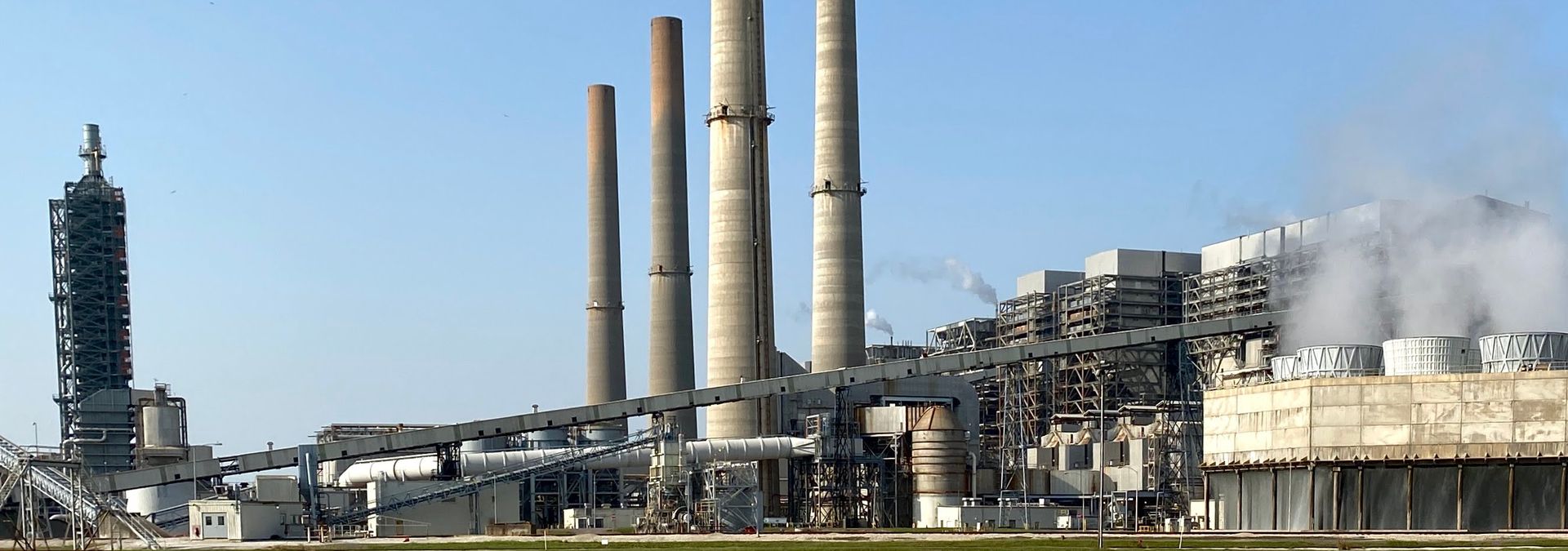
What is sulfur dioxide?
The W. A. Parish plant near Houston is the second-largest source of sulfur dioxide in Texas. Photo: Allyn West.
Sulfur dioxide (SO₂) is a gas released into the air when fossil fuels are burned — when power plants burn coal, for example, or when petrochemical facilities refine crude oil. It also comes from the diesel fuel burned and emitted from cars and heavy-duty trucks, like those that serve concrete batch plants or dumps.
According to the Environmental Protection Agency, sulfur dioxide negatively impacts human and environmental health and atmospheric visibility. It damages trees and contributes to acid rain, which creates a cascade of harms to ecosystems across the world. Even brief exposure to sulfur dioxide can make breathing difficult. Children and people with asthma are particularly susceptible.
If refineries do not carefully remove, store and ship sulfur dioxide, it can bond with other chemicals in the air to form particulate matter, or soot. That is a separate, larger problem. The tiny particles (about 2.5 micrometers or smaller) in soot contribute to regional haze and can also penetrate the lungs, cause inflammation and lead to a range of health problems, like heart disease. In fact, researchers with Harvard University and Environmental Defense Fund concluded that particulate matter in Houston in just 2015 alone led to nearly 5,200 premature deaths and $50 billion in economic impacts.
How does sulfur dioxide impact the Houston region?
As the world has already burned up much of the higher-quality fossil fuels, which have lower sulfur levels, refineries now must process fuels with more sulfur.
According to Barry Lefer, who’s an atmospheric scientist at NASA and previously at the University of Houston, refineries in Houston specialize in extracting fuel from these sources. High-sulfur fossil fuels are shipped to Houston from the Gulf, Canada, Venezuela and elsewhere because Houston’s refineries are equipped to work with this kind of fuel.
Coal, for example, is shipped to NRG’s W.A. Parish power plant, located near Sugar Land in Fort Bend County. The complex is home to two massive four-unit plants: one natural gas, and one coal. Though the plant contributes to haze that can be seen all the way in Arkansas, the greater Houston region is bearing the immediate brunt of its harmful emissions. Parish is the second-largest source of sulfur dioxide, and the largest source of particulate matter, in all of Texas.
Lefer says that Houston is getting close to exceeding the federal health-based standards for particulate matter — standards, he says, that “epidemiological studies show are too high” already. The World Health Organization and other countries have stricter standards, for example. And, this spring, the Trump EPA’s leadership declined to strengthen the standard despite the recommendations of its own scientists, who concluded that 10,000 lives a year could be saved with it.
What can be done?
The federal Clean Air Act, passed in 1970, helped reduce air pollution from vehicles. Catalytic converters help, too.
But coal-fired power plants like Parish create the overwhelming majority of sulfur dioxide in the air, according to Dr. Daniel Cohan, associate professor of Civil and Environmental Engineering at Rice University.
These plants need to install “scrubbers.” Scrubbers work by passing sulfur dioxide through a system that sprays limestone and water on it. The chemical reaction allows for the sulfur dioxide to be removed before it escapes into the atmosphere.
“Scrubbers remove more than 90 percent of sulfur from power plant exhaust and have been required at all new plants since the early 1980s,” Cohan says. “However, only one of the four coal units at Parish has a scrubber, since the other three were built just before the requirement took effect.”
A stricter regulation on scrubbers would help in Texas, though the Texas Commission on Environmental Quality has not implemented one on par with other states. “Most states have required scrubbers to comply with various policies," Cohan says, "like the Regional Haze Rule and other standards.”
Parish already has catalytic converters and electrostatic precipitators, which charge sulfur dioxide particles and then trap them on a screen, to help with particulate matter and NOx control, but Parish lacks the comprehensive scrubbers for sulfur dioxide. What could be even more impactful than investing in installing scrubbers is replacing coal plants altogether with cleaner energy sources and implementing a global reduction in electricity use.
Through legislation, regulation, stricter standards and energy innovation, we can build a path to air scrubbed, for good, of sulfur dioxide.
Ludwin is a writer and editor in Houston.
STAY UP TO DATE
The quality of our newsletter is considered satisfactory and poses little or no risk.
SUBSCRIBE

